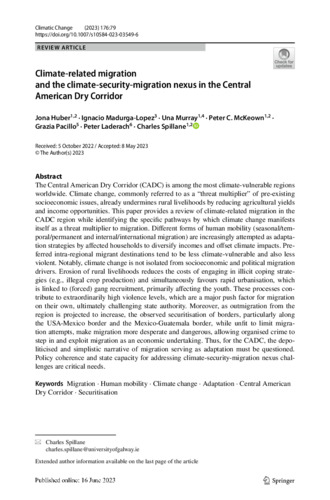Climate-related migration and the climate-security-migration nexus in the Central American Dry Corridor
Abstract
The Central American Dry Corridor (CADC) is among the most climate-vulnerable regions worldwide. Climate change, commonly referred to as a “threat multiplier” of pre-existing socioeconomic issues, already undermines rural livelihoods by reducing agricultural yields and income opportunities. This paper provides a review of climate-related migration in the CADC region while identifying the specific pathways by which climate change manifests itself as a threat multiplier to migration. Different forms of human mobility (seasonal/temporal/permanent and internal/international migration) are increasingly attempted as adaptation strategies by affected households to diversify incomes and offset climate impacts. Preferred intra-regional migrant destinations tend to be less climate-vulnerable and also less violent. Notably, climate change is not isolated from socioeconomic and political migration drivers. Erosion of rural livelihoods reduces the costs of engaging in illicit coping strategies (e.g., illegal crop production) and simultaneously favours rapid urbanisation, which is linked to (forced) gang recruitment, primarily affecting the youth. These processes contribute to extraordinarily high violence levels, which are a major push factor for migration on their own, ultimately challenging state authority. Moreover, as outmigration from the region is projected to increase, the observed securitisation of borders, particularly along the USA-Mexico border and the Mexico-Guatemala border, while unfit to limit migration attempts, make migration more desperate and dangerous, allowing organised crime to step in and exploit migration as an economic undertaking. Thus, for the CADC, the depoliticised and simplistic narrative of migration serving as adaptation must be questioned. Policy coherence and state capacity for addressing climate-security-migration nexus challenges are critical needs.

